Unveiling a Shield of Hope: A Novel Multiepitope-Based Immunogen for Cross-Serotype Cellular Defense against Dengue Virus
Abstract
:1. Introduction
2. Materials and Methods
2.1. Study Design
2.2. Mice
2.3. Cell Line
2.4. DENV Peptides
2.5. Proteome Retrieval for Antigen Prediction and MHC-I T Cell Epitope Prediction
2.6. Design of the Nucleotide Sequence Encoding the Immunogen and Its Subcloning in Expression Vector
2.7. Production of Recombinant H2DVE Polypeptide in Mammalian Expression System
2.8. Generation of Murine pH2DVE-Transfected BMDCs
2.9. Immunization
2.10. T Cell Stimulation
2.11. Enzyme Linked Immunosorbent Assay (ELISA)
2.12. Flow Cytometry
2.13. Statistical Analyses
3. Results
3.1. Identification of T Cell Epitopes from DENV E Protein
3.2. Immunogen Construction and Its Physicochemical Characterization
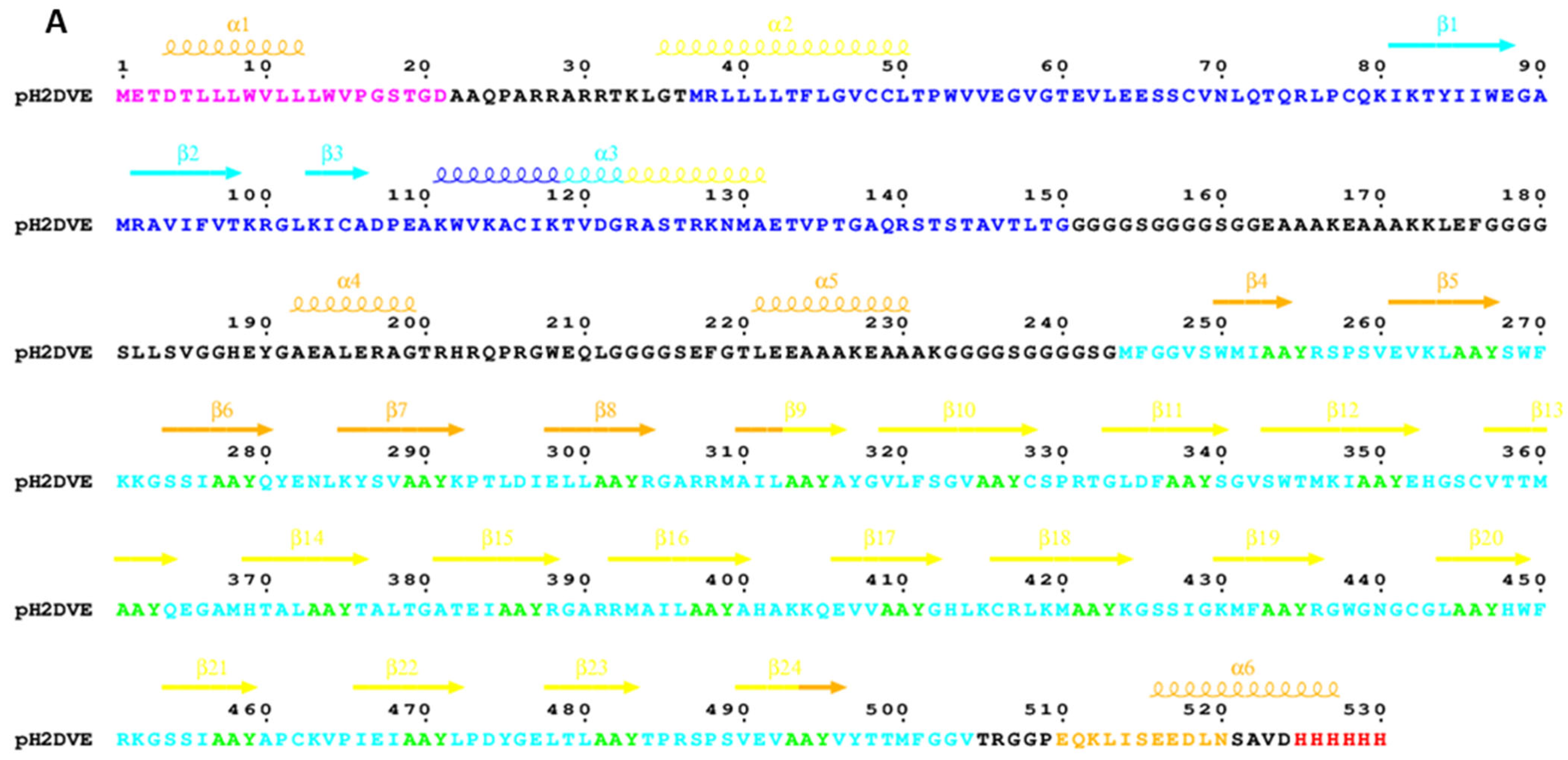
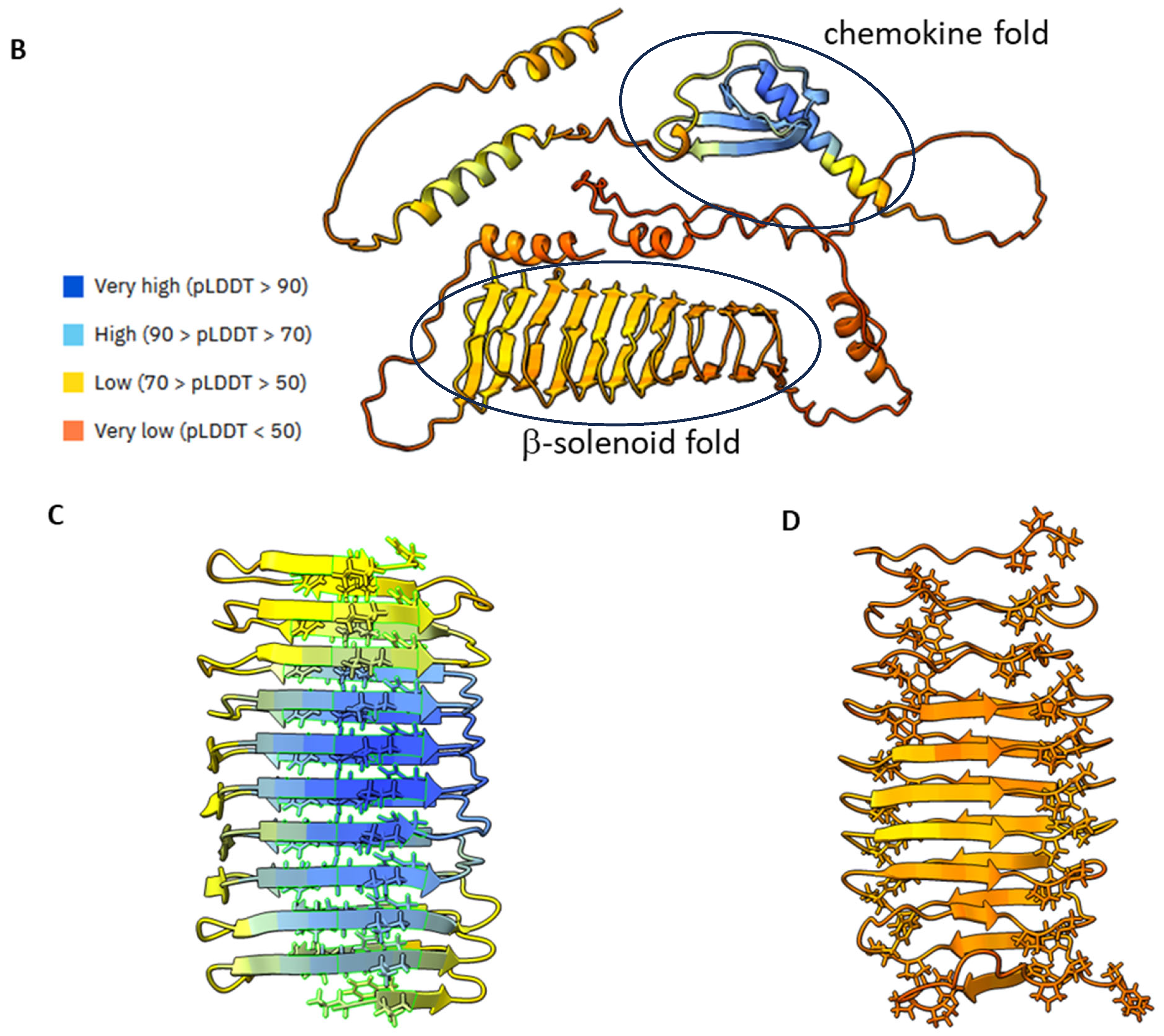
3.3. Codon-Optimized Synthesis, Subcloning, and Expression Profiling of H2DVE Encoding Nucleotide Sequence
3.4. Recombinant H2DVE Is Expressed by the Bone-Marrow Derived Dendritic Cells
3.5. Immunization with pH2DVE-Transfected BMDCs Primed a CD8 T Cell Immune Response to DENV Peptides
4. Discussion
Supplementary Materials
Author Contributions
Funding
Institutional Review Board Statement
Informed Consent Statement
Data Availability Statement
Acknowledgments
Conflicts of Interest
References
- Wilder-Smith, A.; Ooi, E.-E.; Horstick, O.; Wills, B. Dengue. Lancet 2019, 393, 350–363. [Google Scholar] [CrossRef]
- Girard, M.; Nelson, C.B.; Picot, V.; Gubler, D.J. Arboviruses: A Global Public Health Threat. Vaccine 2020, 38, 3989–3994. [Google Scholar] [CrossRef] [PubMed]
- Guzman, M.G.; Gubler, D.J.; Izquierdo, A.; Martinez, E.; Halstead, S.B. Dengue Infection. Nat. Rev. Dis. Primers 2016, 2, 16055. [Google Scholar] [CrossRef] [PubMed]
- Sawant, J.; Patil, A.; Kurle, S. A Review: Understanding Molecular Mechanisms of Antibody-Dependent Enhancement in Viral Infections. Vaccines 2023, 11, 1240. [Google Scholar] [CrossRef]
- Laporta, G.Z.; Potter, A.M.; Oliveira, J.F.A.; Bourke, B.P.; Pecor, D.B.; Linton, Y.-M. Global Distribution of Aedes aegypti and Aedes albopictus in a Climate Change Scenario of Regional Rivalry. Insects 2023, 14, 49. [Google Scholar] [CrossRef] [PubMed]
- Tajudeen, Y.A.; Oladunjoye, I.O.; Mustapha, M.O.; Mustapha, S.T.; Ajide-Bamigboye, N.T. Tackling the Global Health Threat of Arboviruses: An Appraisal of the Three Holistic Approaches to Health. Health Promot. Perspect. 2021, 11, 371–381. [Google Scholar] [CrossRef] [PubMed]
- Bhatt, S.; Gething, P.W.; Brady, O.J.; Messina, J.P.; Farlow, A.W.; Moyes, C.L.; Drake, J.M.; Brownstein, J.S.; Hoen, A.G.; Sankoh, O.; et al. The Global Distribution and Burden of Dengue. Nature 2013, 496, 504–507. [Google Scholar] [CrossRef] [PubMed]
- Hladish, T.J.; Pearson, C.A.B.; Toh, K.B.; Rojas, D.P.; Manrique-Saide, P.; Vazquez-Prokopec, G.M.; Halloran, M.E.; Longini, I.M. Designing Effective Control of Dengue with Combined Interventions. Proc. Natl. Acad. Sci. USA 2020, 117, 3319–3325. [Google Scholar] [CrossRef]
- Ogunlade, S.T.; Meehan, M.T.; Adekunle, A.I.; Rojas, D.P.; Adegboye, O.A.; McBryde, E.S. A Review: Aedes-Borne Arboviral Infections, Controls and Wolbachia-Based Strategies. Vaccines 2021, 9, 32. [Google Scholar] [CrossRef]
- Ogunlade, S.T.; Meehan, M.T.; Adekunle, A.I.; McBryde, E.S. A Systematic Review of Mathematical Models of Dengue Transmission and Vector Control: 2010–2020. Viruses 2023, 15, 254. [Google Scholar] [CrossRef]
- Katzelnick, L.C.; Gresh, L.; Halloran, M.E.; Mercado, J.C.; Kuan, G.; Gordon, A.; Balmaseda, A.; Harris, E. Antibody-Dependent Enhancement of Severe Dengue Disease in Humans. Science 2017, 358, 929–932. [Google Scholar] [CrossRef]
- Shukla, R.; Ramasamy, V.; Shanmugam, R.K.; Ahuja, R.; Khanna, N. Antibody-Dependent Enhancement: A Challenge for Developing a Safe Dengue Vaccine. Front. Cell Infect. Microbiol. 2020, 10, 572681. [Google Scholar] [CrossRef] [PubMed]
- Capeding, M.R.; Tran, N.H.; Hadinegoro, S.R.S.; Ismail, H.I.H.J.M.; Chotpitayasunondh, T.; Chua, M.N.; Luong, C.Q.; Rusmil, K.; Wirawan, D.N.; Nallusamy, R.; et al. Clinical Efficacy and Safety of a Novel Tetravalent Dengue Vaccine in Healthy Children in Asia: A Phase 3, Randomised, Observer-Masked, Placebo-Controlled Trial. Lancet 2014, 384, 1358–1365. [Google Scholar] [CrossRef]
- Sridhar, S.; Luedtke, A.; Langevin, E.; Zhu, M.; Bonaparte, M.; Machabert, T.; Savarino, S.; Zambrano, B.; Moureau, A.; Khromava, A.; et al. Effect of Dengue Serostatus on Dengue Vaccine Safety and Efficacy. N. Engl. J. Med. 2018, 379, 327–340. [Google Scholar] [CrossRef] [PubMed]
- Maier, S.B.; Massad, E.; Amaku, M.; Burattini, M.N.; Greenhalgh, D. The Optimal Age of Vaccination Against Dengue with an Age-Dependent Biting Rate with Application to Brazil. Bull. Math. Biol. 2020, 82, 12. [Google Scholar] [CrossRef]
- Ooi, E.E.; Kalimuddin, S. Insights into Dengue Immunity from Vaccine Trials. Sci. Transl. Med. 2023, 15, eadh3067. [Google Scholar] [CrossRef] [PubMed]
- Thomas, S.J. Is New Dengue Vaccine Efficacy Data a Relief or Cause for Concern? npj Vaccines 2023, 8, 55. [Google Scholar] [CrossRef]
- Sekaran, S.D.; Ismail, A.A.; Thergarajan, G.; Chandramathi, S.; Rahman, S.K.H.; Mani, R.R.; Jusof, F.F.; Lim, Y.A.L.; Manikam, R. Host Immune Response against DENV and ZIKV Infections. Front. Cell Infect. Microbiol. 2022, 12, 975222. [Google Scholar] [CrossRef]
- Torres-Flores, J.M.; Reyes-Sandoval, A.; Salazar, M.I. Dengue Vaccines: An Update. BioDrugs 2022, 36, 325–336. [Google Scholar] [CrossRef] [PubMed]
- Rothman, A.L. Immunity to Dengue Virus: A Tale of Original Antigenic Sin and Tropical Cytokine Storms. Nat. Rev. Immunol. 2011, 11, 532–543. [Google Scholar] [CrossRef]
- Elong Ngono, A.; Shresta, S. Cross-Reactive T Cell Immunity to Dengue and Zika Viruses: New Insights Into Vaccine Development. Front. Immunol. 2019, 10, 1316. [Google Scholar] [CrossRef] [PubMed]
- Zellweger, R.M.; Eddy, W.E.; Tang, W.W.; Miller, R.; Shresta, S. CD8+ T Cells Prevent Antigen-Induced Antibody-Dependent Enhancement of Dengue Disease in Mice. J. Immunol. 2014, 193, 4117–4124. [Google Scholar] [CrossRef] [PubMed]
- Zellweger, R.M.; Tang, W.W.; Eddy, W.E.; King, K.; Sanchez, M.C.; Shresta, S. CD8+ T Cells Can Mediate Short-Term Protection against Heterotypic Dengue Virus Reinfection in Mice. J. Virol. 2015, 89, 6494–6505. [Google Scholar] [CrossRef] [PubMed]
- Elong Ngono, A.; Chen, H.-W.; Tang, W.W.; Joo, Y.; King, K.; Weiskopf, D.; Sidney, J.; Sette, A.; Shresta, S. Protective Role of Cross-Reactive CD8 T Cells Against Dengue Virus Infection. EBioMedicine 2016, 13, 284–293. [Google Scholar] [CrossRef] [PubMed]
- Zellweger, R.M.; Miller, R.; Eddy, W.E.; White, L.J.; Johnston, R.E.; Shresta, S. Role of Humoral versus Cellular Responses Induced by a Protective Dengue Vaccine Candidate. PLoS Pathog. 2013, 9, e1003723. [Google Scholar] [CrossRef]
- Adikari, T.N.; Di Giallonardo, F.; Leung, P.; Grifoni, A.; Sette, A.; Weiskopf, D.; Bull, R.A.; Luciani, F. Conserved Epitopes with High HLA-I Population Coverage Are Targets of CD8+ T Cells Associated with High IFN-γ Responses against All Dengue Virus Serotypes. Sci. Rep. 2020, 10, 20497. [Google Scholar] [CrossRef]
- Ali, M.; Pandey, R.K.; Khatoon, N.; Narula, A.; Mishra, A.; Prajapati, V.K. Exploring Dengue Genome to Construct a Multi-Epitope Based Subunit Vaccine by Utilizing Immunoinformatics Approach to Battle against Dengue Infection. Sci. Rep. 2017, 7, 9232. [Google Scholar] [CrossRef]
- Fadaka, A.O.; Sibuyi, N.R.S.; Martin, D.R.; Goboza, M.; Klein, A.; Madiehe, A.M.; Meyer, M. Immunoinformatics Design of a Novel Epitope-Based Vaccine Candidate against Dengue Virus. Sci. Rep. 2021, 11, 19707. [Google Scholar] [CrossRef]
- Manocha, N.; Kumar, P.; Khanna, M. Immunoinformatic Approach to Design CTL Epitope Based Chimeric Vaccine Targeting Multiple Serotypes of Dengue Virus. bioRxiv 2024. [Google Scholar] [CrossRef]
- Fukushima, A.; Yamaguchi, T.; Ishida, W.; Fukata, K.; Taniguchi, T.; Liu, F.-T.; Ueno, H. Genetic Background Determines Susceptibility to Experimental Immune-Mediated Blepharoconjunctivitis: Comparison of Balb/c and C57BL/6 Mice. Exp. Eye Res. 2006, 82, 210–218. [Google Scholar] [CrossRef]
- Hatcher, E.L.; Zhdanov, S.A.; Bao, Y.; Blinkova, O.; Nawrocki, E.P.; Ostapchuck, Y.; Schäffer, A.A.; Brister, J.R. Virus Variation Resource—Improved Response to Emergent Viral Outbreaks. Nucleic Acids Res. 2017, 45, D482–D490. [Google Scholar] [CrossRef]
- Reynisson, B.; Alvarez, B.; Paul, S.; Peters, B.; Nielsen, M. NetMHCpan-4.1 and NetMHCIIpan-4.0: Improved Predictions of MHC Antigen Presentation by Concurrent Motif Deconvolution and Integration of MS MHC Eluted Ligand Data. Nucleic Acids Res. 2020, 48, W449–W454. [Google Scholar] [CrossRef]
- Tenzer, S.; Peters, B.; Bulik, S.; Schoor, O.; Lemmel, C.; Schatz, M.M.; Kloetzel, P.-M.; Rammensee, H.-G.; Schild, H.; Holzhütter, H.-G. Modeling the MHC Class I Pathway by Combining Predictions of Proteasomal Cleavage, TAP Transport and MHC Class I Binding. Cell Mol. Life Sci. 2005, 62, 1025–1037. [Google Scholar] [CrossRef]
- Velders, M.P.; Weijzen, S.; Eiben, G.L.; Elmishad, A.G.; Kloetzel, P.M.; Higgins, T.; Ciccarelli, R.B.; Evans, M.; Man, S.; Smith, L.; et al. Defined Flanking Spacers and Enhanced Proteolysis Is Essential for Eradication of Established Tumors by an Epitope String DNA Vaccine. J. Immunol. 2001, 166, 5366–5373. [Google Scholar] [CrossRef] [PubMed]
- Schubert, B.; Kohlbacher, O. Designing String-of-Beads Vaccines with Optimal Spacers. Genome Med. 2016, 8, 9. [Google Scholar] [CrossRef]
- Matsuo, K.; Kitahata, K.; Kawabata, F.; Kamei, M.; Hara, Y.; Takamura, S.; Oiso, N.; Kawada, A.; Yoshie, O.; Nakayama, T. A Highly Active Form of XCL1/Lymphotactin Functions as an Effective Adjuvant to Recruit Cross-Presenting Dendritic Cells for Induction of Effector and Memory CD8+ T Cells. Front. Immunol. 2018, 9, 2775. [Google Scholar] [CrossRef]
- Niwa, T.; Ying, B.-W.; Saito, K.; Jin, W.; Takada, S.; Ueda, T.; Taguchi, H. Bimodal Protein Solubility Distribution Revealed by an Aggregation Analysis of the Entire Ensemble of Escherichia Coli Proteins. Proc. Natl. Acad. Sci. USA 2009, 106, 4201–4206. [Google Scholar] [CrossRef] [PubMed]
- The UniProt Consortium UniProt: The Universal Protein Knowledgebase in 2023. Nucleic Acids Res. 2023, 51, D523–D531. [CrossRef]
- Jumper, J.; Evans, R.; Pritzel, A.; Green, T.; Figurnov, M.; Ronneberger, O.; Tunyasuvunakool, K.; Bates, R.; Žídek, A.; Potapenko, A.; et al. Highly Accurate Protein Structure Prediction with AlphaFold. Nature 2021, 596, 583–589. [Google Scholar] [CrossRef] [PubMed]
- Kuloglu, E.S.; McCaslin, D.R.; Kitabwalla, M.; Pauza, C.D.; Markley, J.L.; Volkman, B.F. Monomeric Solution Structure of the Prototypical “C” Chemokine Lymphotactin. Biochemistry 2001, 40, 12486–12496. [Google Scholar] [CrossRef]
- Iengar, P.; Joshi, N.V.; Balaram, P. Conformational and Sequence Signatures in Beta Helix Proteins. Structure 2006, 14, 529–542. [Google Scholar] [CrossRef] [PubMed]
- Robert, X.; Gouet, P. Deciphering Key Features in Protein Structures with the New ENDscript Server. Nucleic Acids Res. 2014, 42, W320–W324. [Google Scholar] [CrossRef] [PubMed]
- Meng, E.C.; Goddard, T.D.; Pettersen, E.F.; Couch, G.S.; Pearson, Z.J.; Morris, J.H.; Ferrin, T.E. UCSF ChimeraX: Tools for Structure Building and Analysis. Protein Sci. 2023, 32, e4792. [Google Scholar] [CrossRef] [PubMed]
- Jitoboam, K.; Phaonakrop, N.; Libsittikul, S.; Thepparit, C.; Roytrakul, S.; Smith, D.R. Actin Interacts with Dengue Virus 2 and 4 Envelope Proteins. PLoS ONE 2016, 11, e0151951. [Google Scholar] [CrossRef]
- Thomas, A.; Thiono, D.J.; Kudlacek, S.T.; Forsberg, J.; Premkumar, L.; Tian, S.; Kuhlman, B.; de Silva, A.M.; Metz, S.W. Dimerization of Dengue Virus E Subunits Impacts Antibody Function and Domain Focus. J. Virol. 2020, 94, e00745-20. [Google Scholar] [CrossRef] [PubMed]
- Zeyaullah, M.; Muzammil, K.; AlShahrani, A.M.; Khan, N.; Ahmad, I.; Alam, M.S.; Ahmad, R.; Khan, W.H. Preparedness for the Dengue Epidemic: Vaccine as a Viable Approach. Vaccines 2022, 10, 1940. [Google Scholar] [CrossRef] [PubMed]
- Cabrera-Mora, M.; Fonseca, J.A.; Singh, B.; Zhao, C.; Makarova, N.; Dmitriev, I.; Curiel, D.T.; Blackwell, J.; Moreno, A. A Recombinant Chimeric Ad5/3 Vector Expressing a Multistage Plasmodium Antigen Induces Protective Immunity in Mice Using Heterologous Prime-Boost Immunization Regimens. J. Immunol. 2016, 197, 2748–2761. [Google Scholar] [CrossRef]
- Khan, M.S.; Kim, E.; Huang, S.; Kenniston, T.W.; Gambotto, A. Trivalent SARS-CoV-2 S1 Subunit Protein Vaccination Induces Broad Humoral Responses in BALB/c Mice. Vaccines 2023, 11, 314. [Google Scholar] [CrossRef]
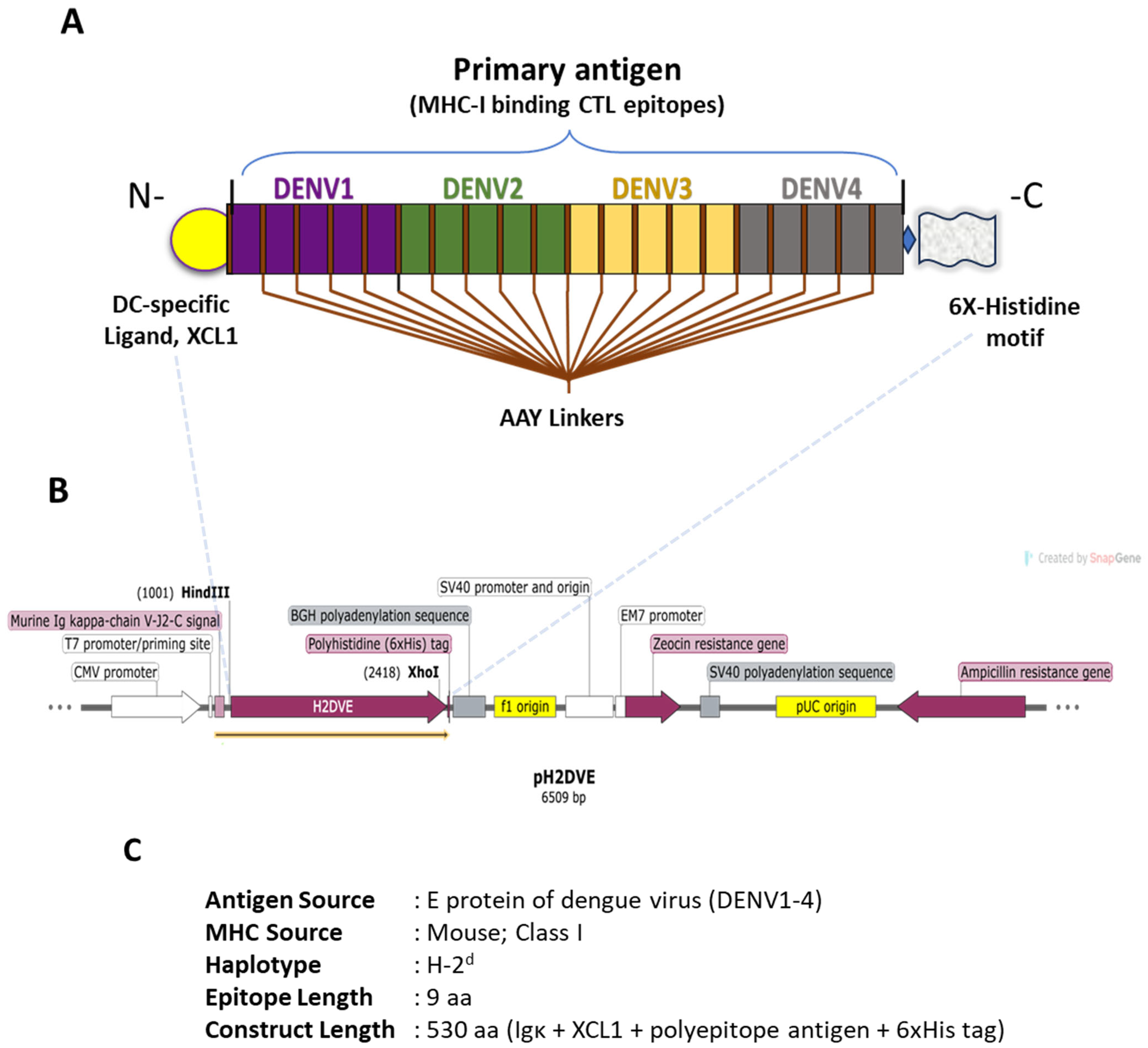

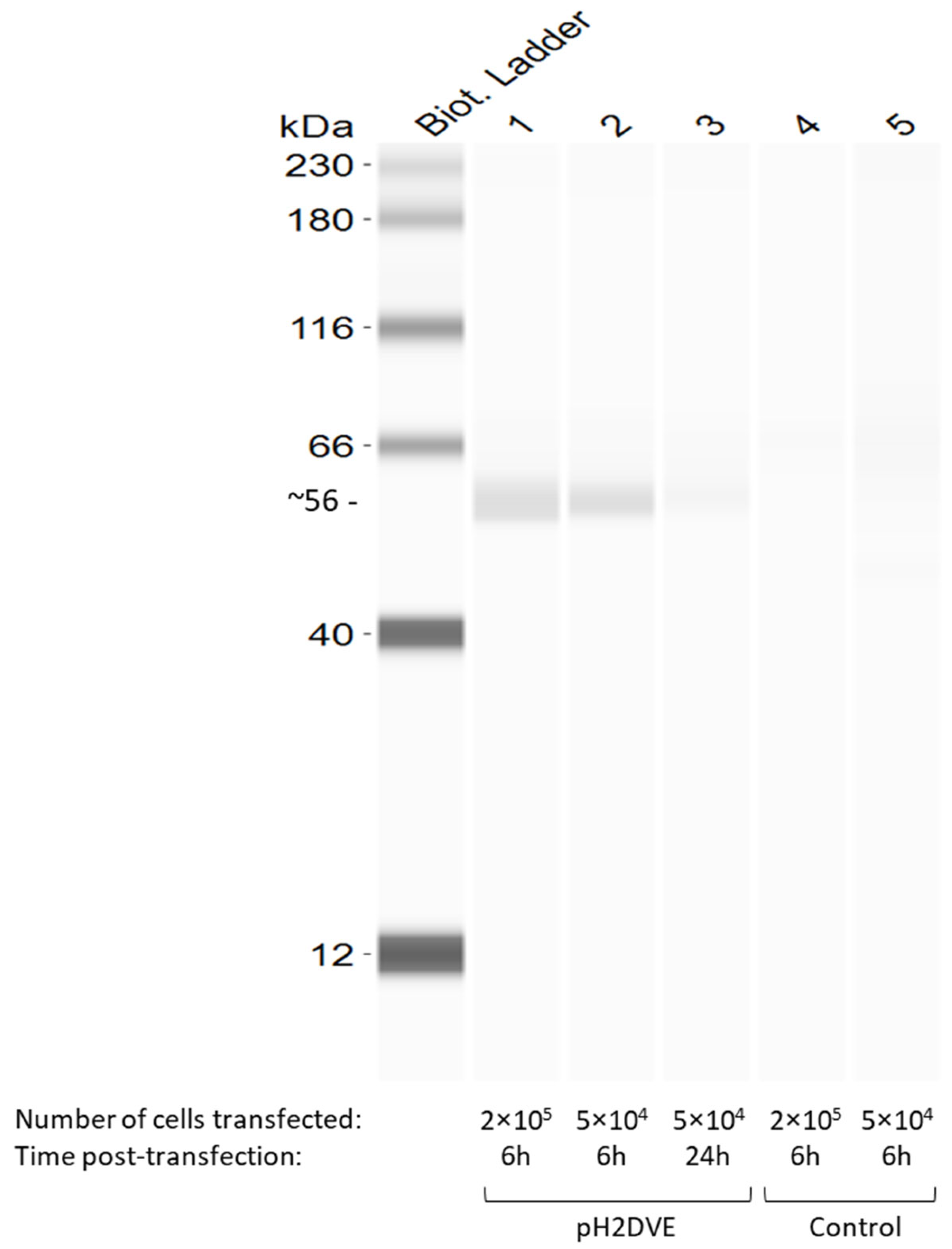
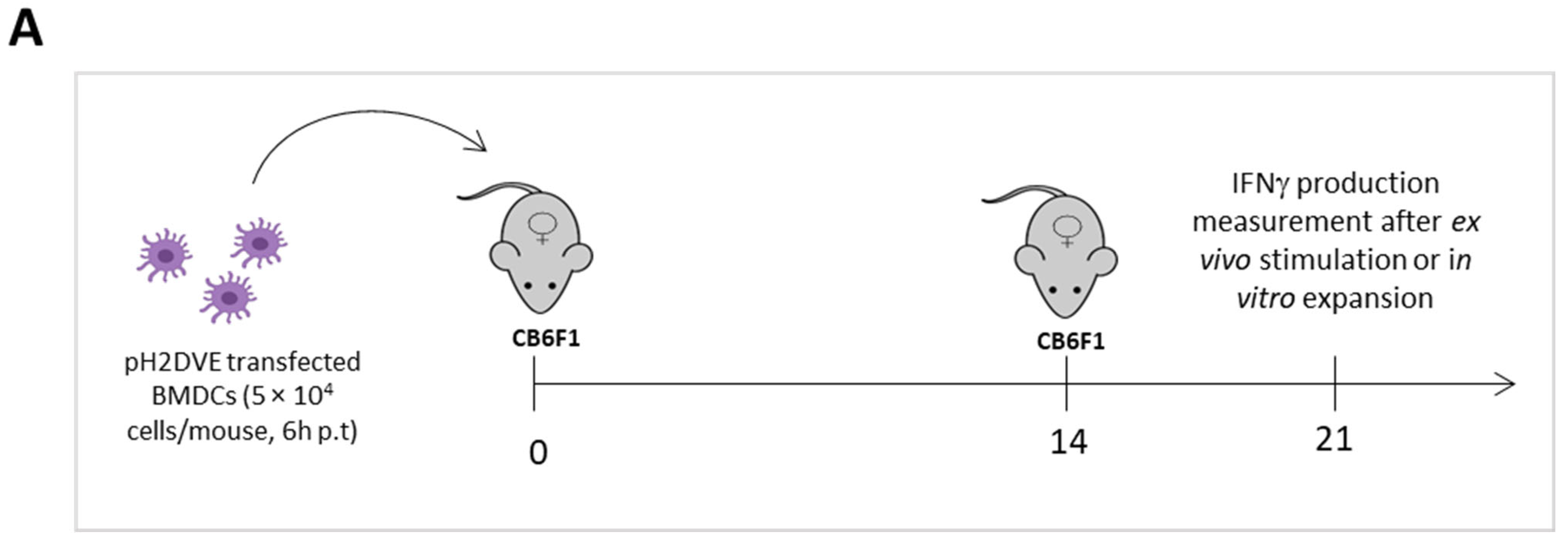
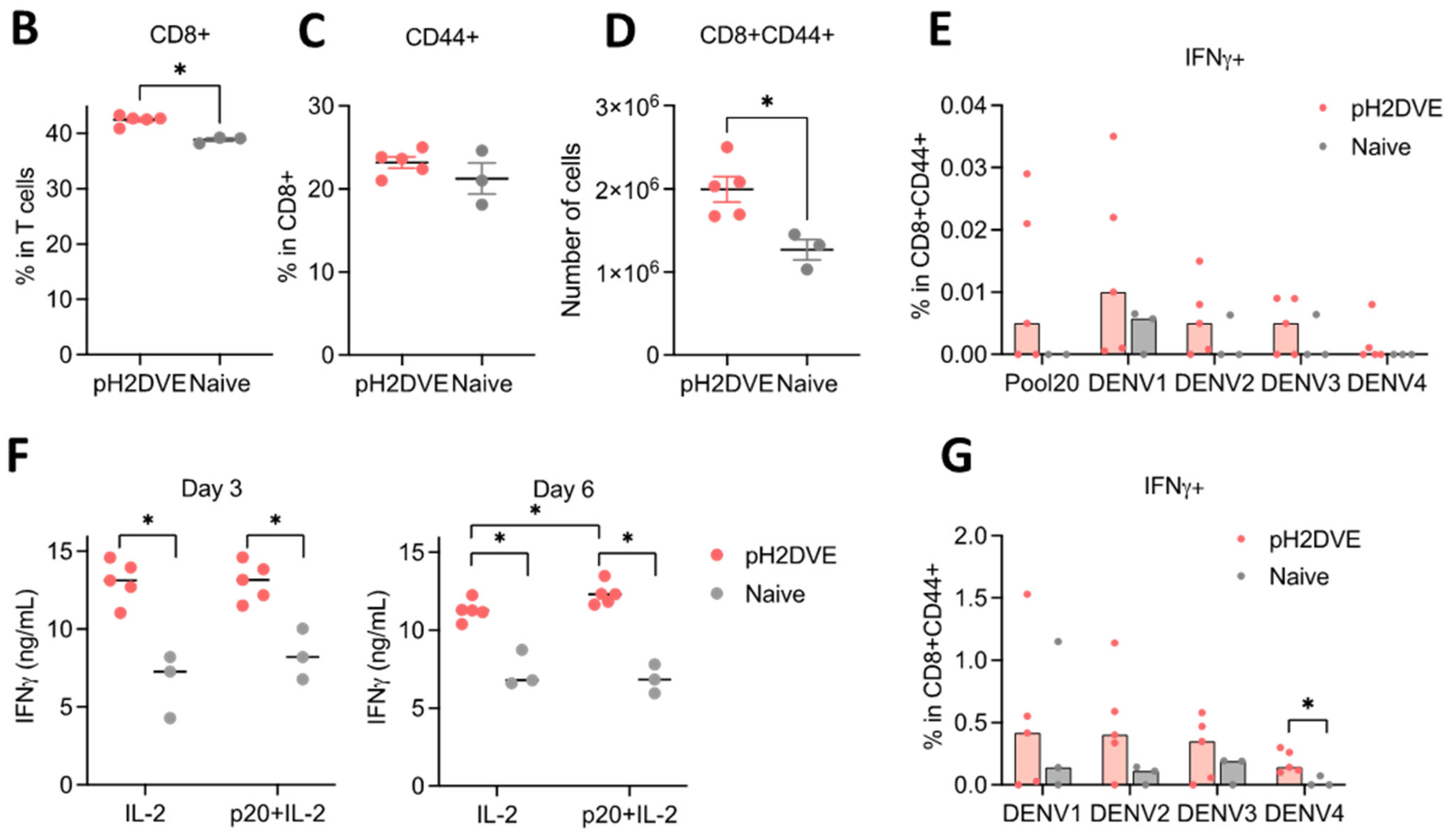
| MHC Class I Binding T Cell Epitopes | Proteasome Score 1 | TAP Score 2 | MHC Score 3 | Processing Score 4 | Total Score 5 | MHC Binding Score 6 | Percentile Rank (PR) 7 |
|---|---|---|---|---|---|---|---|
| DENV1 | |||||||
| SWFKKGSSI | 0.88 | 0.43 | −2.01 | 1.31 | −0.70 | 0.660011 | 0.04 |
| QYENLKYSV | 0.91 | 0.21 | −3.01 | 1.12 | −1.89 | 0.553404 | 0.07 |
| KPTLDIELL | 1.59 | 0.25 | −3.76 | 1.84 | −1.92 | 0.342336 | 0.16 |
| RGARRMAIL * | 1.64 | 0.48 | −2.60 | 2.12 | −0.48 | 0.136102 | 0.09 |
| AYGVLFSGV | 0.87 | 0.25 | −2.94 | 1.12 | −1.82 | 0.383199 | 0.16 |
| DENV2 | |||||||
| CSPRTGLDF | 1.14 | 1.02 | −3.48 | 2.16 | −1.32 | 0.058325 | 0.3 |
| SGVSWTMKI | 1.14 | 0.13 | −3.36 | 1.27 | −2.09 | 0.035419 | 0.57 |
| EHGSCVTTM | 1.18 | 0.00 | −3.42 | 1.17 | −2.24 | 0.054472 | 1.3 |
| QEGAMHTAL | 1.44 | 0.32 | −3.98 | 1.76 | −2.22 | 0.047737 | 1.5 |
| TALTGATEI | 1.09 | 0.24 | −2.95 | 1.33 | −1.62 | 0.046412 | 1.5 |
| DENV3 | |||||||
| RGARRMAIL * | 1.64 | 0.34 | −2.60 | 1.98 | −0.62 | 0.136102 | 0.09 |
| AHAKKQEVV | 1.20 | 0.27 | −2.98 | 1.47 | −1.51 | 0.091084 | 0.84 |
| GHLKCRLKM | 0.87 | 0.13 | −3.15 | 1.00 | −2.15 | 0.053015 | 1.3 |
| KGSSIGKMF | 1.41 | 1.07 | −4.06 | 2.49 | −1.57 | 0.02693 | 0.78 |
| RGWGNGCGL | 1.46 | 0.42 | −3.79 | 1.88 | −1.91 | 0.01558 | 1.4 |
| DENV4 | |||||||
| HWFRKGSSI | 0.93 | 0.37 | −2.36 | 1.30 | −1.06 | 0.463186 | 0.11 |
| APCKVPIEI | 1.42 | 0.15 | −3.60 | 1.57 | −2.03 | 0.459134 | 0.09 |
| LPDYGELTL | 1.54 | 0.25 | −3.62 | 1.79 | −1.83 | 0.36346 | 0.14 |
| TPRSPSVEV | 1.14 | 0.02 | −3.74 | 1.16 | −2.58 | 0.263743 | 0.27 |
| VYTTMFGGV | 0.92 | 0.28 | −2.78 | 1.20 | −1.58 | 0.260915 | 0.29 |
| Property | Value/Score * | Interpretation/Result |
|---|---|---|
| No. of amino acids | 530 | |
| Molecular Weight | 56 kDA | - |
| Theoretical pI | 9.22 | Basic |
| Half-life (mammalian) | 30 h | - |
| Half-life (yeast) | >20 h | - |
| Half-life (E. coli) | >10 h | - |
| Aliphatic Index | 77.51 | Thermostable |
| Instability Index II | 34.99 | Stable |
| Hydropathicity (GRAVY) | −0.041 | Hydrophilic |
| Solubility (Protein-Sol) | 0.554 | Soluble |
| Solubility (SOLpro) (for primary antigen) | 0.637505 | Soluble |
| Transmembrane tendency (ProtScale and DeepTMHMM) | - | No transmembrane state |
| Coiled-coil structures (DeepCoil) | - | No coiled-coil domains |
| Allergenicity | - | Non-allergen |
| Antigenicity | Antigenic | |
| Vaxijen | 0.48 | |
| ANTIGENpro | 0.54 | |
| Helices | 28.95% | - |
| Coils | 47.57% | - |
| Strands | 23.48% | - |
Disclaimer/Publisher’s Note: The statements, opinions and data contained in all publications are solely those of the individual author(s) and contributor(s) and not of MDPI and/or the editor(s). MDPI and/or the editor(s) disclaim responsibility for any injury to people or property resulting from any ideas, methods, instructions or products referred to in the content. |
© 2024 by the authors. Licensee MDPI, Basel, Switzerland. This article is an open access article distributed under the terms and conditions of the Creative Commons Attribution (CC BY) license (https://creativecommons.org/licenses/by/4.0/).
Share and Cite
Manocha, N.; Laubreton, D.; Robert, X.; Marvel, J.; Gueguen-Chaignon, V.; Gouet, P.; Kumar, P.; Khanna, M. Unveiling a Shield of Hope: A Novel Multiepitope-Based Immunogen for Cross-Serotype Cellular Defense against Dengue Virus. Vaccines 2024, 12, 316. https://doi.org/10.3390/vaccines12030316
Manocha N, Laubreton D, Robert X, Marvel J, Gueguen-Chaignon V, Gouet P, Kumar P, Khanna M. Unveiling a Shield of Hope: A Novel Multiepitope-Based Immunogen for Cross-Serotype Cellular Defense against Dengue Virus. Vaccines. 2024; 12(3):316. https://doi.org/10.3390/vaccines12030316
Chicago/Turabian StyleManocha, Nilanshu, Daphné Laubreton, Xavier Robert, Jacqueline Marvel, Virginie Gueguen-Chaignon, Patrice Gouet, Prashant Kumar, and Madhu Khanna. 2024. "Unveiling a Shield of Hope: A Novel Multiepitope-Based Immunogen for Cross-Serotype Cellular Defense against Dengue Virus" Vaccines 12, no. 3: 316. https://doi.org/10.3390/vaccines12030316
APA StyleManocha, N., Laubreton, D., Robert, X., Marvel, J., Gueguen-Chaignon, V., Gouet, P., Kumar, P., & Khanna, M. (2024). Unveiling a Shield of Hope: A Novel Multiepitope-Based Immunogen for Cross-Serotype Cellular Defense against Dengue Virus. Vaccines, 12(3), 316. https://doi.org/10.3390/vaccines12030316







